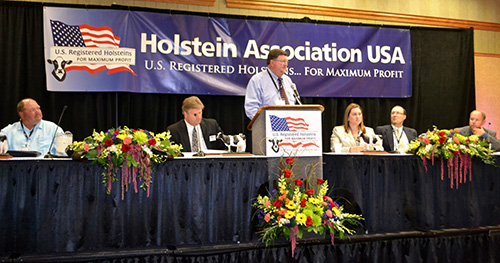
"If you are not on DHIA test or contributing other data such as classification or health data, you can use genomics, but submitting data is critical," Dan Weigel (who works in outcomes research at Zoetis) told those attending the 130th annual Holstein Association USA convention. "Because it's phenotypes that drive the system."
Weigel gave those comments as a member of a four-person panel that shed additional insight on the DNA-based study of genetics.
"Because of genomics, commercial dairy farmers have now taken a great interest in genetics," Nate Zwald of Alta Genetics reminded the audience. As far as the sheer volume of data coming into the system to recalibrate genomic predictions, the U.S. remains the gold standard, explained Zwald, who is general manager of Alta's U.S. division. "However, some countries like Canada have a higher proportion of phenotypic information going into the system."
"The depth and breadth of records are a distinct advantage for the Holstein breed," added Michael Bishop, the senior market development specialist for Illumina, who has been working with genomics since ground zero. Bishop also touched on the fact that Holsteins accounted for 86 percent of all genomic-tested dairy animals in the U.S. last year.
"Once we had the genomic chip figured out, it's population size that drives the genomic information system. That's where Holsteins have held a distinct advantage," added Zwald.
"How can we improve genomics?" was a question panelists fielded from the audience.
Access to phenotypic data was a consistent response to the topic. However, accurate identification was something that genomics itself brought to the table.
"Once we get accurate IDs figured out, we're well on our way, but the frequency of sire assignment errors is often 15 to 20 percent," said Weigel.
"Accuracy of sire and dam ID is one of the great positives about genomics," said Chuck Ripp, who is owner and partner of Ripp's Dairy Valley in Dane, Wis. "Genomic provides me better ideas on culling and helps me manage inbreeding. That is why we test 95 percent of heifers on our 1,000-cow dairy," said Ripp, who performs embryo transfer on his top-end heifers, using sexed semen on the next tier, and places conventional unsexed semen or embryos in the bottom genetic group.
"Our whole herd goal is to use the genomic information to improve the entire herd," said Ripp. "It costs me $2,150 to raise a heifer. The $21,000 to $25,000 on genomic testing annually is well worth it because our goal is to milk the best 1,000 cows on Ripp's Dairy Valley," said the Wisconsin dairyman.
"You are buying information when you run genomic tests. Have confidence to cull the bad ones and replicate the good ones," concurred Weigel.
As for the future . . . "There are no clear-cut answers on genomics. You are going where you have never gone before as a breed," Bishop reminded Holstein breed leaders.
(c) Hoard's Dairyman Intel 2015
June 29, 2015








